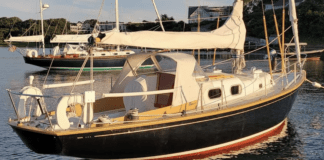
We were motoring in calm seas about 40 miles off the coast of Fort Myers, Fla. when the bilge alarm on the Endeavour 42 went off. The boat was a loaner, borrowed from a friend who figured Id be a good person to help him work out all the kinks of his refit. As it turned out, the boat had very few kinks; the holes, however, proved troublesome.
I was pretty sure what had set off the alarm. The boats icebox drained into the bilge; precious ice was melting faster than Id expected. I gave the helm to my sailing partner, Andrew Tanner, and went below.
I peered into the bilge. A steady stream of water flowed from the aft cabin, under the engine and spilled into the sump. I dabbed my finger in it-salt. Definitely not the icebox. The electric bilge pump was keeping up with the flow, but the water was troubling. Maybe the stuffing box, I thought.
It was nearly sunset, and my 12-year-old son Ben, worn out from a day of sailing, was napping in the aft cabin, sprawled sideways across the queen berth where he could catch some breeze from the hatch above.
I flicked on my headlamp and lifted the floorboard over the stuffing box. The dripless shaft seal was doing its job, but a stream of the clear water snaked along the port side, following low spots in the shallow bilge. I was mystified.
I opened drawers and lockers and followed the stream aft. I checked a compartment below the air conditioner compressor. Water pulsed through a gap in the joinery.
I rolled Ben (still snoozing) over to the other side of the bunk and tried to pry open a shelf further aft to find the source of the water. No dice. The coffin-sized compartment was sealed off, completely inaccessible. Somewhere beneath the furniture, water was pumping into the boat.
I returned my attention to the area under the AC compressor. I poked a screwdriver at the gap where the water flowed. Water spurted out, as if Id punched a hole in the side of fish tank. This was worse than I thought.

Enter the Hammer
A few years back, I reflected upon the dangers of hammers on boats. During our years in the islands, our 18-ounce framing hammer had caused untold harm to some of the more delicate gear (flimsy pieces of $#%&, was the phrase I used at the time) aboard our ketch Tosca. I advised readers to keep the tool far out of reach, especially when engaged in repairs that called for a jewelers patience. I was grateful that the boats owner hadnt read that particular piece. His ash-handled hammer sat in the top of his toolbox, along with a half-dozen loose sockets.
The thin plywood easily gave way to blows from claw-side of the hammer. Varnished veneer and long fractured bits of wood sailed through the cabin. Ben, always a sound sleeper, didnt even stir.
After three blows, Id ripped open an armhole. I blindly reached in and felt a pool of water, a through-hull with no ball valve . . . and then a hose. Water pumped through a long crack in the hose. I pried and whacked some more until I could shine a light on the leak.
Technically, this was an above the waterline through-hull. It drained the propane locker. But with the Endeavour underway, the through-hull was immersed; the above-the-waterline drain had become a below-the-waterline hole in the boat.
Using self-amalgamating tape and duct tape, I was able to stem the flow, but the sponginess of the wire-reinforced rubber hose convinced me to seal the through-hull altogether. The sun was setting as I slipped overboard. Trying not to think about the shark-shredded tuna head that Id reeled in an hour earlier, I quickly bunged the through-hull with a tapered plug – using again the handy hammer.
With the hole plugged, I let loose with a string of curses. I ranted about poor access, I ranted about shoddy workmanship, I ranted about negligent boat builders. I also cursed my own poor judgment. Although Id carefully noted every below-the-waterline through hull (the Endeavour 42 is riddled with them) and had tapered plugs for each of these, I hadnt bothered to track the ones above the waterline. When I launched a new volley of curses, Tanner wisely took the hammer from my hand.
Two hours later, the bilge was dry, and I was back at the helm, practicing deep breathing, and sipping on a hot cup of tea. Ben, who had awoken briefly to serve as a spotter when I went into the water, was back in his bunk. I peered back through the hatch into the aft cabin, where light from the full moon was flooding in. He was fast asleep.
The photos above tell the rest of the tale: Check your hoses, mates. Inside and out.








































